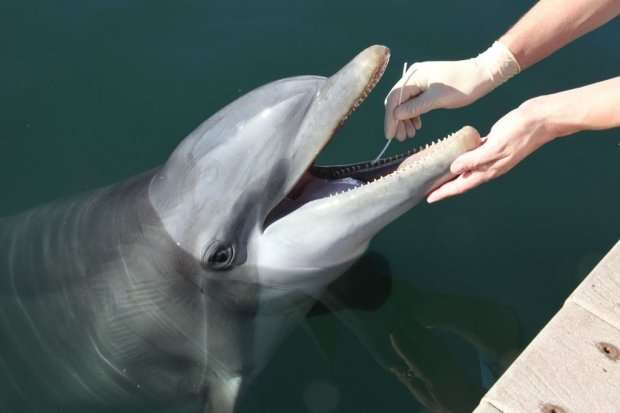Researchers discover poorly understood bacterial lineages in the mouths of dolphins

Researchers have identified two deep lineages of bacteria that have never been characterized before—and they found them in a dolphin's toothy grin.
These deep lineages are known as phyla. A phylum is a broad taxonomic rank that groups together organisms that share a set of common characteristics due to common ancestry. The discovery of two bacterial phyla, as well as additional novel genes and predicted products, provides new insights into bacterial diversity, dolphin health and the unique nature of marine mammals in general, said David Relman, MD, professor of medicine and of microbiology and immunology at the School of Medicine.
A paper describing the research was published Nov. 16 in Current Biology. Relman, who holds the Thomas C. and Joan M. Merigan Professorship, is the senior author. The lead author is Natasha Dudek, a graduate student at UC-Santa Cruz.
The U.S. Navy's Marine Mammal Program reached out to Relman more than 10 years ago for help in keeping its dolphins healthy. The animals are highly trained and perform missions at sea.
Previous research by Relman's group, in collaboration with the Marine Mammal Center, revealed a surprising number of never-before-seen bacteria in dolphin and other marine mammal samples, particularly those swabbed from the dolphins' mouths, said Relman, who is also chief of infectious diseases at the Veterans Affairs Palo Alto Health Care System. Some of the bacteria found in the current study are affiliated with poorly understood branches of the bacterial tree.
"These organisms, about which we have known just a tiny bit, are basically the dark matter of the biological world," he said. "We knew there was gold in those dolphin mouths, and we decided it was time to go after it with more comprehensive methods."
Striking gold
In the new study, the researchers identified bacterial lineages by reconstructing their genomes from short bits of DNA. The genome of a given cell serves as its blueprint and contains all its operating instructions, encoded in DNA. The researchers named one of the newly identified lineages Delphibacteria, in honor of the dolphins (Delphinidae is the Latin name for oceanic dolphins).
By looking at the genes encoded in the genomes of Delphibacteria representatives, the researchers gained insight into the bacteria's lifestyle. The bacteria are predicted to express a property called denitrification that may affect dolphins' oral health: The chemical process can cause inflammation and could be connected to gum disease. Denitrification also occurs in plaque on human teeth, suggesting that something about mammalian mouths selects for this process.
Investigating bacterial lifestyle
The researchers differentiated between bacteria and predicted their behavior by looking broadly at their genomes. "What we do first is shear the DNA into a bunch of little bits and pieces, the mix of DNA is sequenced and we then try to figure out how the genomes were originally assembled," said Dudek. If a gene is one piece of a puzzle, the researchers put together the whole puzzle. This approach has been spearheaded by collaborator and study co-author Jillian Banfield, PhD, at UC-Berkeley.
"Typically, people are interested in small Cas9 proteins that might be easy to manipulate and deliver into cells," said Relman. "These are the opposite—they're enormously big." Different structures in the genes that encode these proteins account for the size difference, and the researchers suggest these large Cas9 proteins have different properties from those known before. Dudek plans to pursue this line of research further.
The study also feeds nicely into ongoing work in Relman's lab. A large, comparative study is underway to investigate how adaptation to life in the sea might affect marine mammal microbiomes. Beyond discovering and characterizing novel bacteria, Relman wants to apply his research to conservation.
"Marine mammals are becoming increasingly endangered," he said. "They are sentinel species for the health of the sea, and the more we can understand their biology, the better we can anticipate changes in the health of their environment."
More information: Natasha K. Dudek et al. Novel Microbial Diversity and Functional Potential in the Marine Mammal Oral Microbiome, Current Biology (2017). DOI: 10.1016/j.cub.2017.10.040
Journal information: Current Biology
Provided by Stanford University Medical Center

















